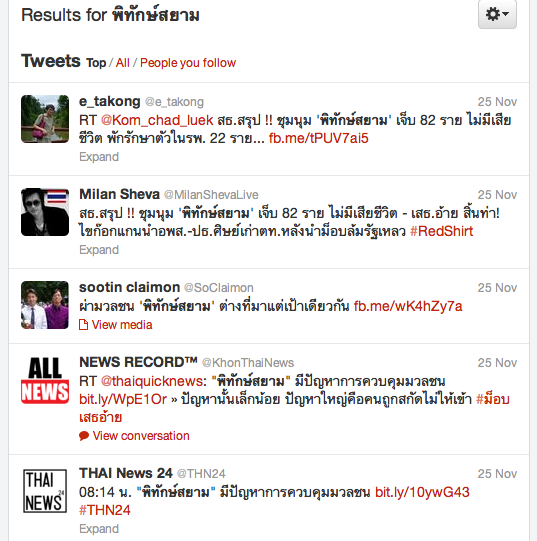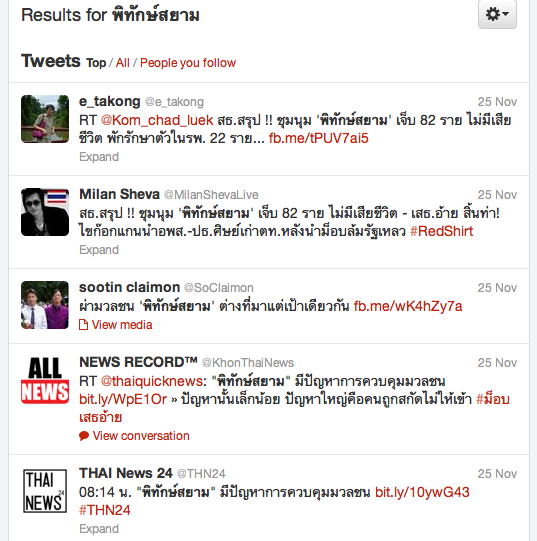“There is no real democracy in Thailand. Elected politicians come from vote-buying, fraud and corruption. We can’t wait for these crooks to be voted out…it may take 100 years to get rid of them. We need to act now…We need to topple this government and freeze democracy for 5 years in order to begin real political reforms.” vowed Seh Ai, leader of the newly formed conservative, anti-government coalition, Pitak Siam.
This weekend the Pitak Siam Organisation (PSO) declared their D-Day where thousands of supporters would gather in the heart of Bangkok to oust elected government of Yingluck Shinawatra. Their “warm-up” rally in late October 2012, which drew an estimated 35,000 demonstrators, suggests anti-government momentum was gathering strength and that time might be “ripe” for what General Boonlert, or Seh Ai, called the last step of his two-stepped ladder. The PSO leaders hoped this D-Day would attract enough supporters to delegitimize the current government and eventually prompt a military intervention.
On 24 November 2012, more than 20,000 supporters turned up to major rally sites in the heart of Bangkok. Prime Minister Yingluck invoked the Internal Security Act (ISA) ahead of the rally, while deputy prime minister Chalerm Yoobamrung cleverly employed deterrence tactics, such as road blocks and checkpoints to hinder protesters from reaching the rally sites. After a somewhat violent morning, where clashes with the authorities led to a few arrests (now released) and use of tear gas, General Boonlert called it quits just before 6pm, stating that the government’s dirty and violent tactics made it unviable for the rallies to continue. He also stepped down as Pitak Siam’s leader.
But this rally is not about the Yingluck government, or the Red Shirts for that matter. Rather, it is an attempt of the former Yellow Shirt forces to recalibrate an identity and position in Thai society. The decline of the movement beginning in 2009, has led to the breakup of its leadership, nasty back-stabbing and significant loss of support. Since the coming to power of yet another Thaksin-aligned party, Pheua Thai, Yellow Shirt forces have continued their activities with mixed success through smaller-scale, albeit targeted, opposition be it via the constitutional court, the military or the privy council. Pitak Siam rallies in late 2012 exemplify a renewed effort to build opposition alliances across various groups and mimic the Yellow Shirt’s pre-coup success.
The Pitak Siam Organisation is the re-incarnation of the 2006 Yellow Shirt Movement, with largely the same supporters and alliances, but with new leadership structure and re-organisation. Pitak Siam brought back former Yellow Shirt-aligned groups that have left the movement following the 193-day rally in 2008, such as Dr. Tul’s Multi Colored Shirts, the Thai Patriot Networks, some sections of the Assembly of the Poor and state enterprise unions, under the guidance of Somsak Kosaisuk, a former People’s Alliance for Democracy (PAD) leader. Pitak Siam endorsed a new leader, a retired army general Boonlert Kaewprasit, in an attempt to elicit support from “old soldiers [who] never die” and entice the current military top brass, which has clearly softened their stance towards the Yingluck government in the past few months. The PAD retreated its role into the back seat, which makes sense given the unpopularity of Sonthi Limthongkul among key groups of PAD’s former alliances. Even so, Pitak Siam admitted using ASTV as one of the main media outlets and relying heavily on Santi Asoke’s Dharma Forces for organisation. The PAD leaders reckoned more than 50 percent of the Pitak Siam supporters are PAD members.
The PSO justify their rallies with three key reasons: 1) the current government turned their eyes blind to, and in some cases supported, lese majeste activities; 2) the Yingluck government is a nominee of Thaksin; 3) continuous and widespread corruption both in terms of government policies and state projects. These are the same grievances the Yellow Shirts trumpeted in the pre-coup period as well as during the Samak-Somchai governments. The leadership hoped to reignite the fire inside those who either loathe Thaksin and/or are fiercely protective of the monarchy. They have purposely sidelined issues that have proved unpopular in previous rallies, such as national sovereignty, and Khao Pra Viharn and kept to the basic, “Nation, Religion, Monarchy”. WIth this in mind the rhetoric is robust. “The crisis, the disaster and the tragedy of this government and its politicians is unprecedented. It’s the biggest threat to our nation. Our demonstrations represent the real power of the people. We have the right to protest and demand our rights, as citizens, back,” said Prasong Soonsiri to the cheering crowd at Nang Leong racecourse.
Yet the real purpose of the Pitak Siam rallies is three-fold. First, the new grouping needs to gauge the size of their supporters to determine the likelihood of future rounds of large-scale mobilisation. Earlier rounds of opposition rallies in 2012, organised by the Multi-Colored Shirts and the Siam Prachapiwat Group, for instance, were able to turn out a maximum of a thousand protesters. Overestimating its own support-base, an expensive lesson the PAD learned in 2010, can lead to movement overreach.
Second, Pitak Siam rallies are meant to lure back old Yellow Shirt supporters and to attract new ones. Campaigns against the Yingluck government’s policies, such as the rice pledging scheme, 300 baht minimum wage and ongoing state infrastructure projects, which have been waged by other opposition groups, are incorporated into Pitak Siam’s protest platforms. These are aimed to gain support among disaffected farmers, community rights activists and business owners.
Third, the new leadership of Seh Ai, endorsed by Yellow Shirt old-timers, such as Pramote Nakorntap, Prasong Soonsiri, and several retired generals and high-ranking civil servants, was strategic. Seh Ai was not an active Yellow Shirt in the past and could conceivably represented some degree of “neutrality” in terms of leadership – a much needed factor given how much bad blood within the various opposition groups over the years. More importantly, as an army general himself, if Seh Ai succeeded in turning out mass rallies against Yingluck government, Pitak Siam would be able to signal strong mass support for military intervention that would overthrow the government. When asked during a Thai PBS interview whether Pitak Siam is calling for a coup, Seh Ai said: “A military coup requires popular support to succeed. If we [Pitak Siam] are able to show the military that we have a lot of supporters then we hope the military would know what to do. The military are there to serve the people…they must stand by the people. If we do well, the military will take our side.”
At this stage, the Pitak Siam rallies failed on a number of fronts, be it in terms of leadership, numbers and coordination among various groups. Nonetheless their continued opposition to the “Thaksin regime” and zealous efforts to preserve their vision of royalist-conservative Thailand will not be abated.
Aim Sinpeng is a doctoral candidate at the University of British Columbia, Canada
 Facebook
Facebook  Twitter
Twitter  Soundcloud
Soundcloud  Youtube
Youtube  Rss
Rss 
